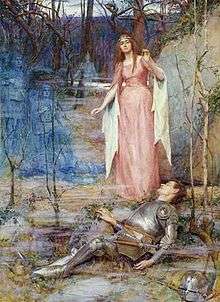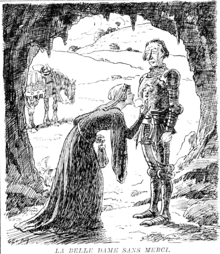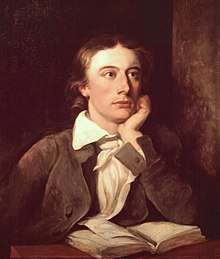La Belle Dame sans Merci
"La Belle Dame sans Merci" ("The Beautiful Lady Without Mercy") is a ballad produced by the English poet John Keats in 1819. The title was derived from the title of a 15th-century poem by Alain Chartier called La Belle Dame sans Mercy.[1]
.jpg)




Considered an English classic, the poem is an example of Keats' poetic preoccupation with love and death.[2] The poem is about a fairy who condemns a knight to an unpleasant fate after she seduces him with her eyes and singing. The fairy inspired several artists to paint images that became early examples of 19th-century femme fatale iconography.[3] The poem continues to be referenced in many works of literature, music, art, and film.
Poem
The poem is simple in structure with twelve stanzas of four lines each in an ABCB rhyme scheme. It employs a brachycatalectic metric, shortening the end of each verse by two syllables. An excerpt from the revised version follows:
Ah, what can ail thee, wretched wight,
Alone and palely loitering;
The sedge is wither'd from the lake,
And no birds sing.
...
I met a Lady in the meads
Full beautiful, a fairy's child;
Her hair was long, her foot was light,
And her eyes were wild.
...
She took me to her elfin grot,
And there she gaz'd and sighed deep,
And there I shut her wild sad eyes—
So kiss'd to sleep.
And there we slumber'd on the moss
And there I dream'd, ah woe betide,
The latest dream I ever dream'd
On the cold hill side.
I saw pale kings, and princes too,
Pale warriors, death-pale were they all;
Who cry'd—"La belle Dame sans mercy
Hath thee in thrall!"
I saw their starv'd lips in the gloom
With horrid warning gaped wide,
And I awoke, and found me here
On the cold hill side.
And this is why I sojourn here
Alone and palely loitering,
Though the sedge is wither'd from the lake,
And no birds sing.[4]— Stanzas 1, 4, 8-12
Inspiration
In 2019 literary scholars Richard Marggraf Turley and Jennifer Squire proposed that the ballad may have been inspired by the tomb effigy of Richard FitzAlan, 10th Earl of Arundel (d. 1376) in Chichester Cathedral. At the time of Keats' visit in 1819, the effigy stood mutilated and separated from that of Arundel's second wife, Eleanor of Lancaster (d. 1372), in the northern outer aisle. The figures were reunited and restored by Edward Richardson in 1843, and later inspired Philip Larkin's 1956 poem "An Arundel Tomb".[5][6]
In other media
Visual depictions
| Wikimedia Commons has media related to La Belle Dame sans Merci. |
"La Belle Dame sans Merci" was a popular subject for the Pre-Raphaelite Brotherhood. It was depicted by Frank Dicksee,[7] Frank Cadogan Cowper, John William Waterhouse,[8] Arthur Hughes,[9] Walter Crane,[10] and Henry Maynell Rheam.[11] It was also satirized in the 1 December 1920 edition of Punch magazine.[12]
Musical settings
Around 1910, Charles Villiers Stanford produced a musical setting for the poem. It is a dramatic interpretation requiring a skilled (male) vocalist and equally skilled accompanist.[13] In the 21st century it remains popular and is included on many anthologies of English song or British Art Music recorded by famous artists.[14]
In 1935, Patrick Hadley wrote a version of the Stanford score for tenor, four-part chorus, and orchestra.[15]
A setting of the poem, in German translation, appears on the 2009 music album Buch der Balladen by Faun.[16]
A lyrical, mystical musical setting of this poem has been composed by Loreena McKennitt, published in her 2018 CD Lost Souls.[17]
Film
The 1915 American film The Poet of the Peaks was based upon the poem.[18]
The 2009 stop-action animated fantasy film Coraline directed by Henry Selick refers to the malevolent Other Mother as "beldam". The film includes a similar theme of entrapment by a seemingly beautiful loving woman.[19]
Books
The poem is mentioned in the story entitled "The case of Three Gables" from the 1893 book The Memoirs of Sherlock Holmes by Sir Arthur Conan Doyle. In it Holmes compares and matches the character sketch of Isadora Klein with La Belle Dame sans Merci.[20]
In Agatha Christie's 1936 mystery novel Murder in Mesopotamia, the plot is centered upon an unusual woman named Louise Leidner who is described multiple times as "a kind of Belle Dame sin Merci". One character describes her as possessing a "calamitous magic that plays the devil with things".[21][22]
Vladimir Nabokov's books The Real Life of Sebastian Knight (1941), Lolita (1955) and Pale Fire (1962) allude to the poem.
The last two lines of the first verse ("The sedge has withered from the lake/And no birds sing") were used as an epigraph for Rachel Carson's book Silent Spring (1962), about the environmental damage caused by the irresponsible use of pesticides. The second line was repeated later in the book, as the title of a chapter about their specific effects on birds.[23]
The last two lines of the 11th verse are used as the title of a science fiction short story, "And I awoke and found me here on the cold hill's side" (1973) by James Tiptree, Jr..[24]
Roger Zelazny's Amber Chronicles refer to the poem in Chapter Five of The Courts of Chaos (1978) wherein the protagonist journeys to a land that resembles the poem.[25]
John Kennedy Toole's novel A Confederacy of Dunces (1980) alludes to the poem in initially describing the main character's home.[26]
Farley Mowat's 1980 memoir of his experiences in World War II is entitled And No Birds Sang.[27]
The line is also featured in Philip Roth's The Human Stain (2000) in reaction to Coleman describing his new, far younger love interest.[28]
In Chapter 32 of Kristine Smith's novel Law Of Survival (2001) the protagonist, Jani, reveals her true hybrid eyes to the general public for the first time, then she asks another character, Niall, what she looks like. Niall smiles and quotes a snippet of La Belle Dame sans Merci and gives Keats credit for his words.[29]
The Beldam in Neil Gaiman's 2002 horror-fantasy novel Coraline references the mysterious woman who is also known as Belle Dame. Both share many similarities as both lure their protagonists into their lair by showing their love towards them and giving them treats to enjoy. The protagonists in both stories also encounter the ghosts who have previously met both women and warn the protagonist about their true colours and at the end of the story, the protagonist is stuck in their lair, with the exception of Coraline who managed to escape while the unnamed knight in this poem is still stuck in the mysterious fairy's lair.[30]
L. A. Meyer's Bloody Jack series (2002-2014) features a take on La Belle Dame sans Merci, adapted to reflect the protagonists age. Mary "Jacky" Faber became known as "La belle jeune fille sans merci".
In Hunting Ground (2009) by Patricia Briggs, La Belle Dame sans Merci is identified as The Lady of the Lake and is a hidden antagonist.[31]
David Foster Wallace's 2011 novel The Pale King alludes to the poem in its title.[32]
Cassandra Clare's 2016 collection of novellas Tales From the Shadowhunter Academy includes a novella titled Pale Kings and Princes, named after the line "I saw pale kings and princes too/Pale warriors, death-pale were they all". Three of the poem's stanzas are also excerpted in the story.[33]
Television
Rosemary & Thyme - Season 1, Episode 1[34]
Californication - Season 1, Episode 5[35]
Downton Abbey - Season 6, Episode 5[36]
Victoria - Season 2, Episode 3[37]
Other
In a March 2017 interview with The Quietus the English songwriter and musician John Lydon cited the poem as a favourite.[38]
In the popular trading card game, Magic the Gathering, the card 'Merieke Ri Berit' is modeled after this poem.[39]
References
- Dana M. Symons (2004). "La Belle Dame sans Mercy – Introduction". Chaucerian Dream Visions and Complaints. Medieval Institute Publications. Archived from the original on 2018-06-27. Retrieved 2018-11-30.
- Everest, Kelvin; British Council (2002). John Keats. Northcote House. p. 86. ISBN 9780746308073. OCLC 50526132.
- Cooper, Robyn (1986). Dean, Sonia; Ryan, Judith (eds.). "Arthur Hughes's La Belle Dame sans merci and the femme fatale". Art Bulletin of Victoria. Council of Trustees of the National Gallery of Victoria. 27. ISSN 0066-7935. OCLC 888714380. Archived from the original on 2017-05-26. Retrieved 2018-11-30.
- Keats, John (1905). Sélincourt, Ernest De (ed.). The Poems of John Keats. New York: Dodd, Mead & Company. pp. 244-247. OCLC 11128824.
- "Old sketches, maps and gothic effigies unlock secrets of John Keats's famous poem 'La Belle Dame Sans Merci'". Aberystwyth University. 16 May 2019. Retrieved 25 December 2019.
- Marggraf Turley, Richard (16 July 2019). "How a stone knight inspired two very different visions of love from John Keats and Philip Larkin". The Conversation. Retrieved 25 December 2019.
- Frank, Dicksee (1890), La Belle Dame Sans Merci, Wikimedia Commons, the free media repository, retrieved 2018-11-30
- Waterhouse, John William (1893), La Belle Dame Sans Merci, Wikimedia Commons, the free media repository, retrieved 2018-11-30
- Hugues, Arthur, La Belle Dame Sans Merci, Wikimedia Commons, the free media repository, retrieved 2018-11-30
- Crane, Walter T. (1865), Le belle Dame Sans Merci, Wikimedia Commons, the free media repository, retrieved 2018-11-30
- Rheam, Henry Meynell (1901), La Belle Dame sans Merci, Wikimedia Commons, the free media repository, retrieved 2018-11-30
- LA BELLE DAME SANS MERCI, Punch, 1920-12-01, retrieved 2018-11-30
- Stanford, Charles Villiers (music), Keats, John (words) (1910). La belle dame sans merci : ballad (For voice and piano) (musical score). London: Augener & Co. OCLC 433495401.
- "La belle dame sans merci - Hyperion Records - CDs, MP3 and Lossless downloads". www.hyperion-records.co.uk. Retrieved 2019-04-08.
- Hadley, Patrick (music), Keats, John (words) (1935). La belle dame sans merci (printed musical score). London: Curwen. OCLC 24862985.
- Faun (Album) (2009). Buch Der Balladen [Book of Ballads] (audio compact disc). ASIN B00CV9225E. OCLC 1010338374.
- McKennitt, Loreena (Artist) (2018). Lost Souls (audio compact disc). New York, NY: Universal Music Enterprises. OCLC 1048033767.
- Eason, Reaves (Director) (1915-04-12). The Poet of the Peaks (motion picture). USA: Mutual Film.
- Henry Selick (Director) (2009). Coraline (motion picture). USA: Focus Features. OCLC 895036872.
- Doyle, Arthur Conan (1893). The Memoirs of Sherlock Holmes.
- Christie, Agatha (author); Bakewell, Michael (2003). Murder in Mesopotamia : A BBC Radio 4 full-cast dramatisation (audio compact disc). Bath: BBC Audiobooks. Event occurs at 01:16:55. ISBN 9780563494232. OCLC 938615128.
POIROT:But Louise Leidner was no ordinary woman. DR REILLY:She certainly was not. She'd got that sort of... calamitous magic that plays the devil with things. Kind of a Belle Dame sans Merci.
- Christie, Agatha (1936). "Chapter 19. A New Suspicion". Murder in Mesopotamia. London: Published for the Crime club by Collins. OCLC 938286864.
But Mrs. Leidner was something out of the ordinary in that line. She'd got just that sort of calamitous magic that plays the deuce with things - a kind of Belle Dame sans Merci.
- Carson, Rachel (2002). Silent Spring. Cambridge, Massachusetts: Houghton Mifflin. ISBN 9780618249060. OCLC 806409808.
- Tiptree, James Jr. (1973). "And I Awoke and Found Me Here on the Cold Hill's Side". Ten thousand light-years from home. New York: Ace Books. OCLC 50687237.
- Zelazny, Roger (1978). "Chapter 5, The Courts of Chaos". Chronicles of Amber. Volume II. Garden City, New York: Nelson Doubleday Pub. OCLC 316235986.
- Toole, John Kennedy (1980). A Confederacy of Dunces. Baton Rouge: Louisiana State University Press. ISBN 9780807106570. OCLC 318457173.
- Mowat, Farley (1979). And No Birds Sang. London: Cassell. ISBN 9780304307470. OCLC 16557956.
- Roth, Philip (2000). The Human Stain. Houghton Mifflin. p. 27. OCLC 930877308.
- Smith, Kristine (2001). "32". Law of Survival. New York, NY: Eos Books. ISBN 9780380807857. OCLC 48105904.
- Gaiman, Neil (2002). Coraline. London: Bloomsbury Publishing. ISBN 9780747558781. OCLC 441090183.
- Briggs, Patricia (2009). Hunting Ground. New York: Berkley Pub. Group. ISBN 9780441017386. OCLC 865278362.
- Wallace, David Foster (2011). The Pale King. London: Hamish Hamilton. ISBN 9780241144800. OCLC 729687079.
- Clare, Cassandra (2016). Tales From the Shadowhunter Academy. London: Walker Books. ISBN 9781406362848. OCLC 1028442554.
- Eastman, Brian; Exton, Clive (2003-08-31). "And No Birds Sing". Rosemary & Thyme. Season 1. Episode 1. OCLC 1040647468. ITV.
- Kampinos, Tom (2007-09-10). "LOL". Californication. Season 1. Episode 5. OCLC 941908978. Showtime.
- Julian, Fellowes (2015-10-18). "Episode 5". Downton Abbey. Season 6. Episode 5. OCLC 932137942. ITV.
- Geoffrey, Sax (2017-09-10). "Warp and Weft". Victoria. Season 2. Episode 3. OCLC 1026276682. ITV.
- The Quietus - John Lydon Official interview LIVE. Facebook. 2017-03-21. Retrieved 2018-11-30.
- "Merieke Ri Berit". MTG Wiki. Retrieved 2020-06-12.
External links
| Wikisource has original text related to this article: |
